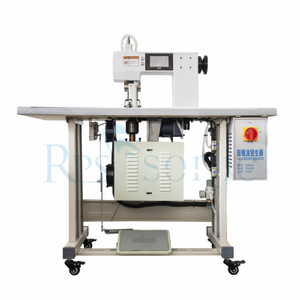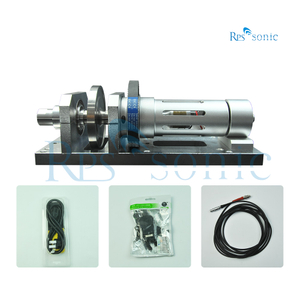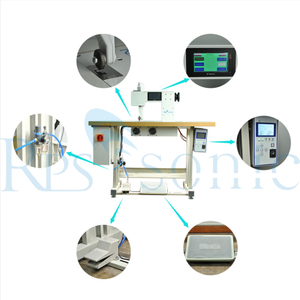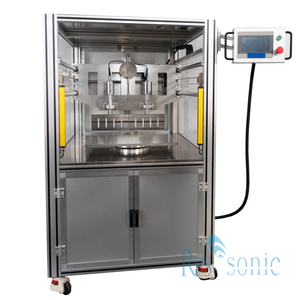Ultrasonic cutting
1.Are there different blade designs available for ultrasonic cutting knives?
Yes, ultrasonic cutting knives come with various blade designs to suit different applications. Some common blade shapes include straight blades, curved blades, serrated blades, and custom-designed blades for specific cutting requirements.
2.Can an ultrasonic cutting knife be used for automated or robotic applications?
Yes, ultrasonic cutting knives can be integrated into automated or robotic systems for precision cutting in industrial settings. They can be controlled and programmed to follow specific cutting paths, making them suitable for high-speed production lines.
3.Is an ultrasonic cutting knife safe to use?
Ultrasonic cutting knives are generally safe to use when operated correctly. However, precautions should be taken to prevent accidental contact with the vibrating blade, and appropriate safety measures, such as guarding and training, should be implemented to ensure operator safety.
4.How do I choose the right ultrasonic cutting knife for my application?
When selecting an ultrasonic cutting knife, consider factors such as the type and thickness of the material to be cut, the desired cutting precision, the required cutting speed, and any specific features or accessories needed for your application. Consulting with the manufacturer or supplier can help in choosing the most suitable knife.
5.Can an ultrasonic cutting knife be used for non-industrial applications?
Yes, ultrasonic cutting knives have applications beyond industrial settings. They can be used in crafts, hobbies, and DIY projects, as well as in research and development laboratories for cutting small samples or delicate materials.
Ultrasonic homogenizer
1.What types of samples can be processed with ultrasonic homogenizers?
Ultrasonic homogenizers can process a wide range of samples, including biological tissues, cells, microorganisms, plant material, pharmaceutical formulations, emulsions, suspensions, and various types of liquids.
2.Are there different sizes and power options available for ultrasonic homogenizers?
Yes, ultrasonic homogenizers come in various sizes and power options to accommodate different sample volumes and processing requirements. They range from small handheld devices for small-scale applications to larger benchtop or industrial-scale systems.
3.How do I choose the right ultrasonic homogenizer for my application?
When choosing an ultrasonic homogenizer, consider factors such as sample volume, processing time, frequency and power settings, sample type, and the specific application requirements. Consulting with the manufacturer or supplier can help in selecting the most suitable device.
4.Can ultrasonic homogenizers be used in combination with other techniques?
Yes, ultrasonic homogenizers can be used in combination with other techniques to enhance the efficiency and effectiveness of sample processing. For example, they can be used in conjunction with enzymatic treatments, mechanical agitation, or temperature control methods to achieve specific results.
5.What is more important when choosing the appropriate device - power rating or amplitude?
Power output is not the sole criterion for selecting the ultrasonic homogeniser. This value only indicates the power of the ultrasonic generator but not the energy delivered into the sample. The amplitude at the radiating surface of the probe is the determining factor while considering the sample volume. RPS-SONIC homogenisers provide higher amplitudes than comparable devices in the market due to an optimal matching of all components.
Ultrasonic welding
1.Is ultrasonic welding a suitable method for sealing or joining packaging materials?
Yes, ultrasonic welding is commonly used for sealing and joining packaging materials, such as blister packs, clamshell packaging, and flexible pouches. It provides hermetic seals and helps maintain the integrity of the packaged contents.
2.Can ultrasonic welding be used to weld dissimilar materials?
It depends on the melting points of the different materials. If the melting points of the two materials are similar, of course, there is no problem. If the melting point of the two materials is very different, the welding effect will be not good
3.Are there different types of ultrasonic welding equipment?
Yes, there are different types of ultrasonic welding equipment available, including handheld units, benchtop machines, and fully automated systems. The choice of equipment depends on the specific application requirements and production volume.
4.What factors should be considered when selecting an ultrasonic welding machine?
When selecting an ultrasonic welding machine, consider key factors such as the material melting points and thickness, desired welding strength, required production speed, part complexity, and any specific features or customization needed for your application.
5.Is ultrasonic welding a safe process?
Ultrasonic welding is generally considered safe when proper safety precautions are followed. Operators should use appropriate personal protective equipment, such as gloves and safety glasses, and ensure that the equipment is properly maintained and operated within specified parameters.
Ultrasonic spray coating
1.Can ultrasonic atomization be used for heat-sensitive or volatile liquids?
Yes, ultrasonic atomization is particularly suitable for heat-sensitive or volatile liquids. The low-temperature operation and gentle atomization process help preserve the integrity and properties of sensitive substances.
2.Are there different types of ultrasonic atomizers available?
Yes, there are different types of ultrasonic atomizers available, including handheld atomizers, benchtop units, and industrial-scale atomization systems. The choice of atomizer depends on the specific application requirements and desired output volume.
3.How do I control the droplet size in ultrasonic atomization?
The droplet size in ultrasonic atomization can be controlled by adjusting parameters such as the ultrasonic frequency, power output, liquid flow rate, and the distance between the transducer and the liquid surface. Different combinations of these parameters can achieve the desired droplet size.
4.Can ultrasonic atomization be used for generating a controlled flow of mist?
Yes, ultrasonic atomization can be used to generate a controlled flow of mist. By regulating the liquid flow rate and the ultrasonic power, it is possible to achieve a consistent and continuous mist output for various applications.
5.Are there any safety considerations when using ultrasonic atomization?
When using ultrasonic atomization, it is important to ensure proper ventilation in the area to prevent the accumulation of mist. Additionally, some substances may require specific safety precautions, such as handling volatile or hazardous liquids in a well-ventilated environment and following appropriate safety guidelines.
 English
English














